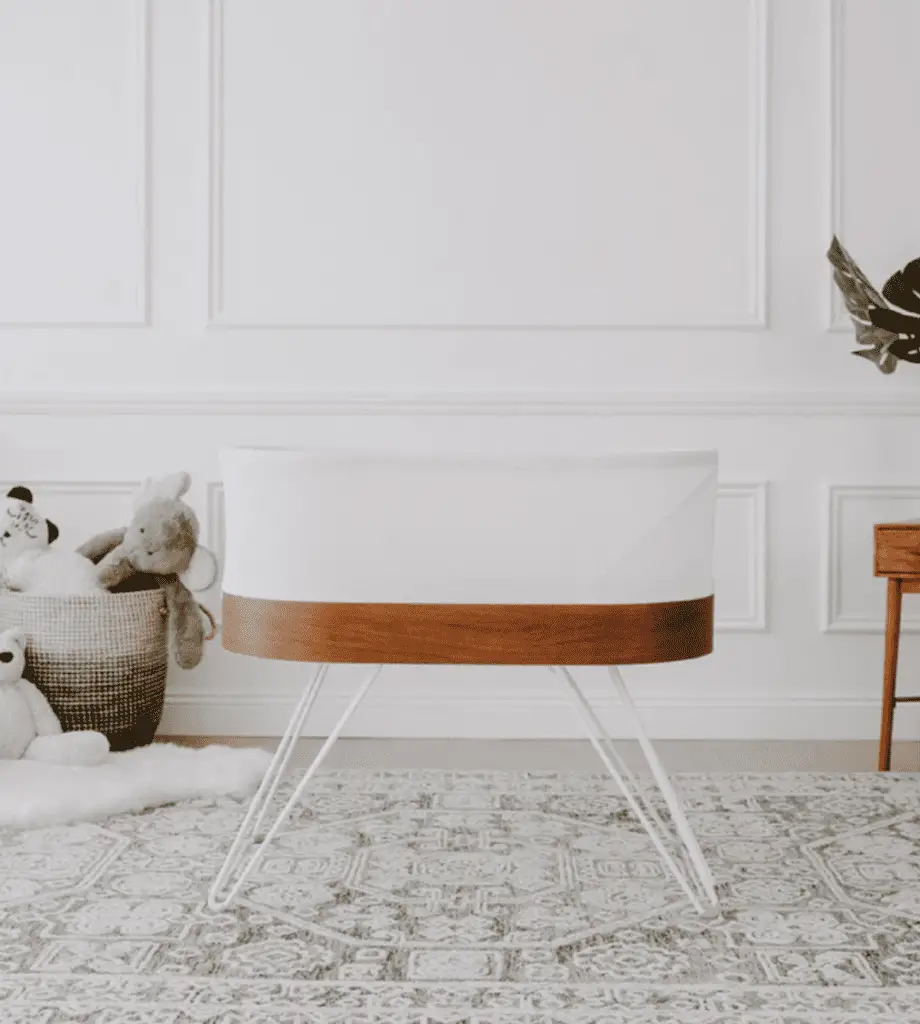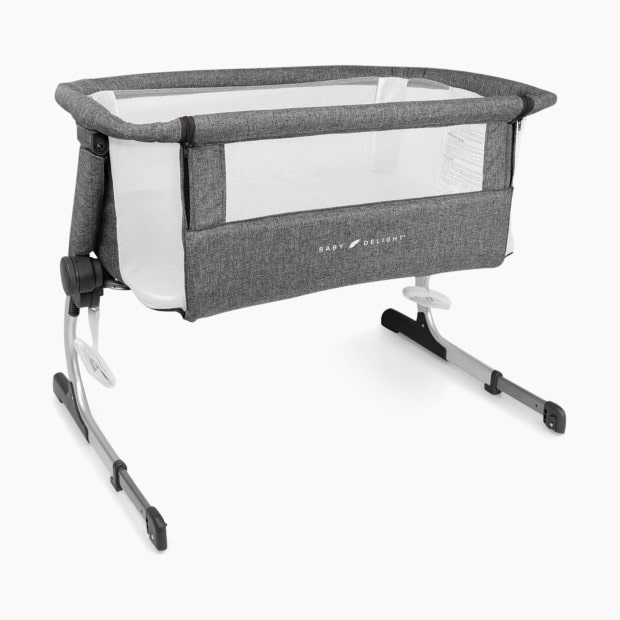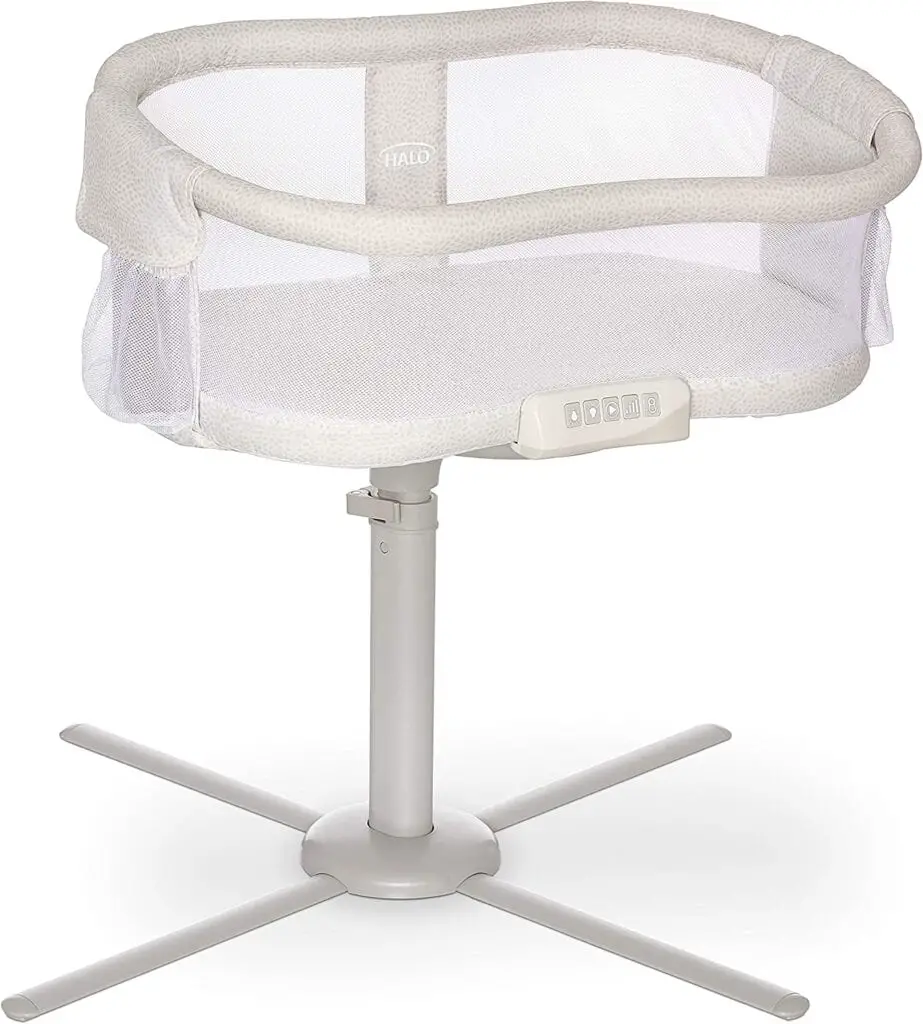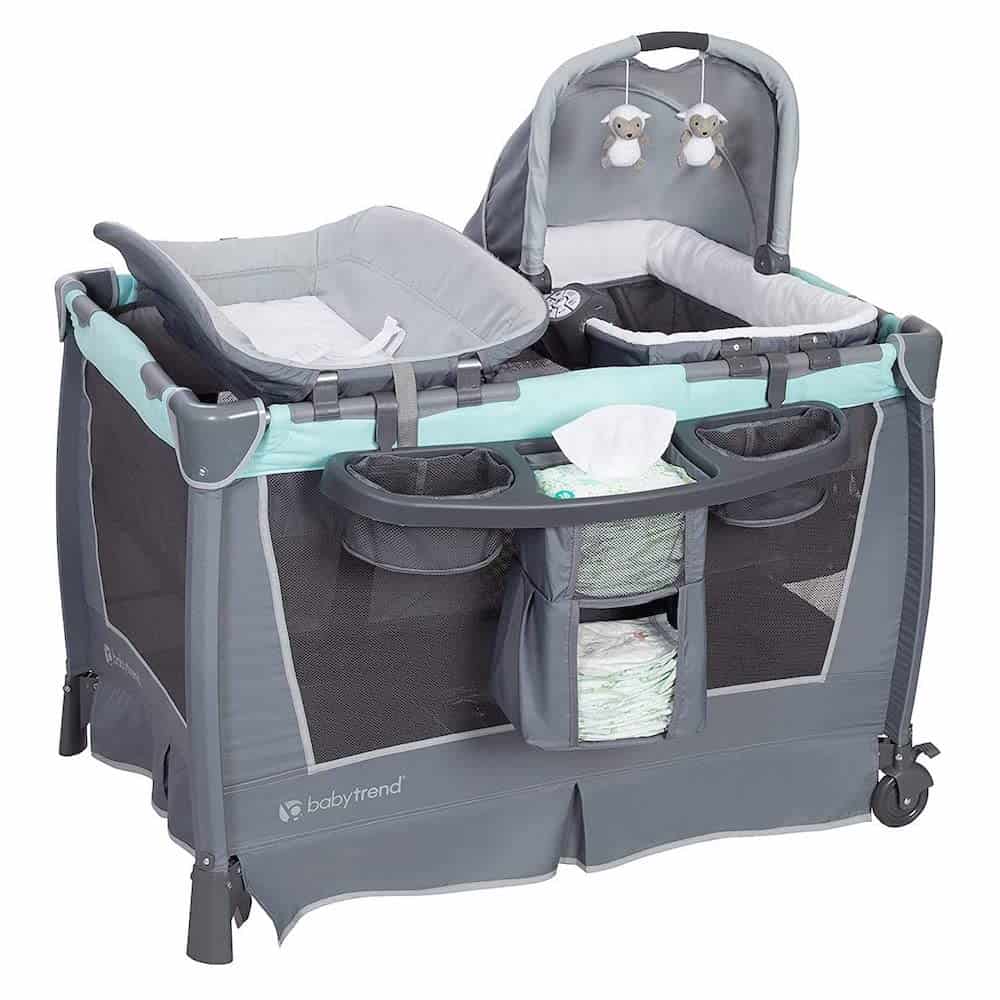If you’ve never cared for a newborn before, the question of where they should sleep might have you stumped. Crib? Cradle? Pack ‘n play? Or should you get one of those little bassinets recommended by every registry site?
(If you’d like to read about ALL the baby products 6,000 moms did (and didn’t) recommend over my six months of research, you can read my essentials-only baby registry checklist article here!)
Navigating the baby gear minefield is really complicated for first time parents. Online guides make everything seem essential, but it’s all so expensive! This week I’m tackling the question of baby bassinets, but I’ve also written an article on whether you need a baby lounger, a baby bathtub, and more.
As a mom of two toddlers (and another little guy on the way!) I certainly have my own opinions on the usefulness of bassinets. But that only reflects my experiences, history, and the kinds of sleepers my babies have been. In order to fully answer the question of whether the average parent needs a bassinet, I had to get more data. So I reached out to veteran parents on social media and asked them for their opinions, the reasons behind them, and all their stories of trial and error. Here’s what they had to say.
What is a bassinet?
This is the first thing my husband asked me when I suggested putting one on a registry. And it’s a good question, because people can mean different things when they say bassinet.
In general, a bassinet is any small, safe sleep surface for a newborn baby. They come in a few different styles, but all max out at fairly low infant weight limits (around 15lbs). This means they’re only meant to be used in the first 3-4 months of a baby’s life. They also tend to be higher when compared to cribs or pack ‘n plays.

So, do I really need a bassinet?
According to a survey of hundreds of parents, 63% said bassinets were an unnecessary purchase. In fact, only 22% thought getting a stand-alone bassinet or co-sleeper bassinet was a worthwhile purchase. The rest suggested getting a pack ‘n play, which has many other functions besides a bassinet.

In creating my question, wanted to specify what style of bassinet parents used to see if that changed their answers. But if you haven’t done much digging into these different bassinet styles yet, let me catch you up.
A co-sleeper bassinet, also called a bedside sleeper, is a small baby bed that connects directly to your bed. It acts as an extension to your sleep surface, which means easy access to your little one at night. They often have a collapsable fourth wall to completely remove any separation between the bassinet and your bed, while still letting your little guy have their own space. This makes co-sleeper bassinets especially good for moms who are breastfeeding and can avoid getting up if the baby is within arm’s reach. If you plan on formula feeding, there isn’t as much reason to get an attachable bassinet, unless easily seeing your baby sleep will reduce your anxiety during the night.


A stand-alone bassinet (aka the “normal” kind) can stand alone, as the name suggests, either on four legs or one center stand with a sturdy base. Some can pivot positions so the bassinet can “swivel” on top of your bed, which again is helpful for breastfeeding moms. There are others kinds in this style, including portable bassinets that fold up, rockers, and “smart” bassinets that sense when your child is waking up and will attempt to soothe them back to sleep with gentle vibrations or sounds.


The only reasons you should get a bassinet
Plenty of moms in the 37% who said bassinets were necessary had good reasons for getting one. There were a few one-off explanations, but these three reasons came up multiple times.
You had a c-section
A number of moms mentioned how much easier it was to care for their baby after a c-section when they had a bassinet. This is because bassinets typically have a sleeping surface that’s much higher than a usual crib. That means much less bending over and down to pick up your baby in the middle of the night, which can be painful after serious abdominal surgery.
Brianna hit on this point exactly, saying that “A cheap, stand alone bassinet was an absolute life saver for me… it was much easier for me to take him in and out of the bassinet after my c-section.”
You want baby close, but have a small room
Doctors recommend keeping your baby in the room with you if possible. It’s also great to have baby close if you’re breastfeeding, since it means maximizing your sleep.
However, you’ll need sleeping options with a small footprint if you have a small bedroom. Full-sized, standard cribs are 52″ x 28″, which takes up almost ten square feet of space.
For the tiniest rooms, even a pack ‘n play might be too big. Pack ‘n plays are much more compact than cribs, but still takes up about 8 square feet of space.
Compare this to the Halo Swivel bassinet or the Arm’s Reach Co-Sleeper Bassinet, both of which take up a mere 4.5 square feet of space.
You value convenience most
If you have the space in both your bedroom and your budget (or if you’re getting a hand-me-down bassinet!), there’s nothing more convenient than having an easily accessible newborn when you’re sleep deprived. If you’re breastfeeding, you can avoid even standing up in the middle of the night with many bassinet types that either attach to or swivel over your bed. There also might be other stressors in your life which make convenience an even more valuable commodity.
Rachel was in this camp, commenting, “So glad I splurged and got [an Arm’s Reach] for baby #2. First child had a pack n play and it was a pain getting up and bending over to pick her up…it’s worth every penny for us.”
Alternatives to a bassinet
Clearly however, most parents are not sold on the idea of a bassinet. So what do they do instead? Here are the four options I heard most frequently in the comments section.
Pack ‘n Play
Over a hundred parents voted for getting a pack ‘n play with a bassinet portion attached. I’m considering this an ‘alternative,’ however, since most parents don’t just buy a pack ‘n play for its bassinet.
I’ve already spent PLENTY of time talking about the multiple uses and benefits of a pack ‘n play, however, so you can go read my article on whether or not you need a pack ‘n play for more detailed information.
Regular crib
After the pack ‘n play, the most common alternative suggested was to just put your newborn baby to sleep in a full sized crib. Many moms commented that they kept the normal-sized crib in their bedrooms (or sometimes in the baby’s own room) right from day one.
Just getting a crib is great, because it means you don’t have to worry about switching out beds after just a few months. It also means you save money because you’re not buying multiple sleep surfaces.
A few parents, Elizabeth included, mentioned that swaddling helps with putting babies in bigger beds. “At first they are swaddled when they sleep, so I don’t think they really cared that the crib was a full size crib. By the time you stop swaddling, they are used to the crib.” For the record, experts suggest you should stop swaddling a baby whenever they can start rolling over. This works, however, because that’s about the same time most babies are ready to transition out of a bassinet- around four months old.
Mini crib
I actually had to look this term up! Mini cribs are a newcomer to the baby gear market. Thankfully, they’re just what they sound like: a crib with all the solid wooden bars you’d expect, but taking up a much smaller amount of space. They tend to work as a sleeping option for your baby much longer than a bassinet will, because they have higher walls. This means a rolling or crawling baby still can’t climb out of a mini crib, unlike a bassinet. Many mini cribs can also transition into a toddler bed later on for even more extended use.
Steph says, “I had [a bassinet] for awhile, but I ended up getting a mini crib and love it! We have a regular sized crib too, but the mini fits our space better and he can be in our room.”
Brandi also had good things to say about her mini crib. “You could get a mini crib, which ends up being a similar price to a bassinet. It can still be bedside like a bassinet, but it will last longer than the bassinet will. Ours outgrew the bassinet at like 5 months I think? Also, there are mini cribs that fold up when not in use, which is pretty cool, too.”
In-bed co-sleeping
This is a controversial option, for sure. The CDC and the American Academy of Pediatrics (AAP) both recommend against any bedsharing practices. There are also different circumstances that can make bedsharing more dangerous (like parents going to bed drunk or taking sedative medication, older siblings also in the bed, the presence of secondhand smoke, and/or having stuffed animals, fluffy blankets, or other kinds of soft bedding around the baby).
However, according to the CDC’s own data, 61% of American families practice some level of bedsharing with their babies, and this option was also represented in the comments of my survey. And I’ll freely admit my family also does co-sleeping for the first few months of each child’s life in addition to having a bedside sleeper bassinet.
Some moms who mentioned co-sleeping added additional aids like bedrails or in-bed bassinets which can provide more of a structured boundary within your adult bed.
The benefits of co-sleeping, however, are not having to spend money on additional baby beds and more sleep for nursing parents who don’t have to fully wake up to feed the baby.
Best Bassinet Options
Here at the end, I wanted to include the specific models moms shouted out as working for them and their families. Before you go and buy one brand new however, remember that pre-loved bassinets are CONSTANTLY showing up at baby consignment stores, on Facebook Marketplace, and being passed around mom’s groups. You can just buy a new mattresses too, if you’re (understandably) nervous about used ones.
I checked a few different places to buy each model, and I tried to link to the website that was currently offering the best price on each.
Arm’s Reach Co-Sleeper

This is the style I was given from a local mom who was done having kids. I never would have expected to use it or find it as useful as I did! It’s great to have a safe spot in your bedroom to put your baby down. And even though we do co-sleeping, it’s also a good place to put them to bed early if you’re not quite ready to join them for the night.
Kait also raved about her Arm’s reach, saying, “They even make a 3in1, so it could be a mini pack and play as well. So it would check off quite a few boxes and is way easier to travel with.”
You can check out an Arm’s Reach Co-Sleeper on the company’s website here.
Baby Trend Retreat Nursery Center

Most of the parents who suggested using a pack ‘n play specifically mentioned getting the style with a detachable bassinet. Baby Trend makes a great version of this, with the additional storage slots for diapers and wipes to make midnight changes easier.
You can check out the Baby Trend pack ‘n play on Amazon here.
HALO BassiNest Swivel Sleeper

The third style of bassinet which multiple moms recommended in my survey was the HALO swivel brand. One of the advantages of a bassinet like the HALO swivel over the Arm’s Reach is bed accessibility for mom. With the Arm’s Reach (or Dream on Me, or other bassinet that’s literally attached to your bed), you need to move around the bassinet to just get in and out of bed. With the HALO, you can just push it aside and get out like normal, but you still have that closeness at night when you need it.
Heather commented in my poll, saying, “We had a Halo and loved that it swiveled over to be on my bed and it make it easy to pick up baby to nurse without even getting out of bed.”
You can check out the HALO BassiNest at Walmart.com here.
There you go! Hopefully, you have a much better sense now of whether a bassinet is necessary for you and your family situation.
If you’d like to get more articles about how to save money while raising a family straight to your email inbox, be sure to sign up for my weekly (or sometimes every other weekly) newsletter below!
